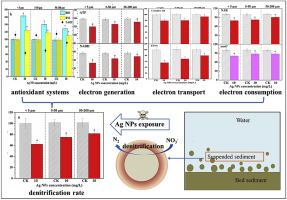当前位置:
X-MOL 学术
›
Water Res.
›
论文详情
Our official English website, www.x-mol.net, welcomes your
feedback! (Note: you will need to create a separate account there.)
Effects of Ag NPs on denitrification in suspended sediments via inhibiting microbial electron behaviors.
Water Research ( IF 11.4 ) Pub Date : 2019-12-27 , DOI: 10.1016/j.watres.2019.115436 Songqi Liu 1 , Chao Wang 1 , Jun Hou 1 , Peifang Wang 1 , Lingzhan Miao 1
Water Research ( IF 11.4 ) Pub Date : 2019-12-27 , DOI: 10.1016/j.watres.2019.115436 Songqi Liu 1 , Chao Wang 1 , Jun Hou 1 , Peifang Wang 1 , Lingzhan Miao 1
Affiliation

|
The wide use of silver nanoparticles (Ag NPs) inevitably leads to their increasing emission into aquatic environments. However, before their final deposition into sediments, the ecological effects of Ag NPs in suspended sediment (SPS) systems have not received much attention. Herein, we investigated the influences of Ag NPs on denitrification in SPS systems, and explored the potential toxicity mechanism through microbial metabolism (electron behaviors) and isotope tracing (added 15NO3-). After exposure to 10 mg/L Ag NPs, electron generation, transport and consumption during denitrification were clearly inhibited, which led to a decrease in the SPS denitrification rate. Specifically, the generation of NADH (electron donor) was significantly decreased to 59.92-86.47% with the Ag NPs treatments by affecting the degradation of glucose, one of the major reasons for the decreased denitrification. It also indicated that Ag NPs could affect nitrogen metabolism by influencing carbon metabolism. In addition, ETSA was clearly inhibited by the affected electron transfer and reception during denitrification; that was the most direct way in the microbial electron transport chain to affect the SPS denitrification rate. Furthermore, the particle size and concentration of SPS affected the toxicity of Ag NPs. The denitrification process in SPS systems with a smaller particle size and lower particle concentration was easily affected by Ag NPs, suggesting that SPS systems dominated by clay (particle size < 3.9 μm) or that less turbulence (having low SPS concentration) might be at greater risk factor when exposed to NPs. Thus, it is important to understand the risks of pollutants, such as Ag NPs, to biogeochemical cycles and ecosystem function in SPS systems.
中文翻译:

Ag NPs通过抑制微生物电子行为对悬浮沉积物中反硝化作用的影响。
银纳米颗粒(Ag NPs)的广泛使用不可避免地导致其向水生环境的排放增加。但是,在悬浮沉积物(SPS)系统中的银纳米颗粒的生态效应在它们最终沉积到沉积物中之前,并未受到太多关注。本文中,我们研究了Ag NPs对SPS系统中反硝化的影响,并通过微生物代谢(电子行为)和同位素示踪(添加15NO3-)探索了潜在的毒性机理。暴露于10 mg / L的Ag NPs后,反硝化过程中的电子生成,运输和消耗明显受到抑制,这导致SPS的反硝化率降低。具体而言,使用Ag NPs处理后,NADH(电子供体)的产生通过影响葡萄糖的降解而显着减少至59.92-86.47%,减少反硝化的主要原因之一。这也表明Ag NPs可通过影响碳代谢而影响氮代谢。此外,反硝化过程中受影响的电子转移和接收明显抑制了ETSA。这是微生物电子传输链中影响SPS反硝化率的最直接方法。此外,SPS的粒径和浓度会影响Ag NPs的毒性。Ag NPs容易影响粒径较小且粒径较低的SPS系统的反硝化过程,这表明以粘土为主(粒径<3.9μm)或湍流较小(SPS浓度较低)的SPS系统可能更大。暴露于NPs的危险因素。因此,了解污染物的风险非常重要,
更新日期:2019-12-27
中文翻译:

Ag NPs通过抑制微生物电子行为对悬浮沉积物中反硝化作用的影响。
银纳米颗粒(Ag NPs)的广泛使用不可避免地导致其向水生环境的排放增加。但是,在悬浮沉积物(SPS)系统中的银纳米颗粒的生态效应在它们最终沉积到沉积物中之前,并未受到太多关注。本文中,我们研究了Ag NPs对SPS系统中反硝化的影响,并通过微生物代谢(电子行为)和同位素示踪(添加15NO3-)探索了潜在的毒性机理。暴露于10 mg / L的Ag NPs后,反硝化过程中的电子生成,运输和消耗明显受到抑制,这导致SPS的反硝化率降低。具体而言,使用Ag NPs处理后,NADH(电子供体)的产生通过影响葡萄糖的降解而显着减少至59.92-86.47%,减少反硝化的主要原因之一。这也表明Ag NPs可通过影响碳代谢而影响氮代谢。此外,反硝化过程中受影响的电子转移和接收明显抑制了ETSA。这是微生物电子传输链中影响SPS反硝化率的最直接方法。此外,SPS的粒径和浓度会影响Ag NPs的毒性。Ag NPs容易影响粒径较小且粒径较低的SPS系统的反硝化过程,这表明以粘土为主(粒径<3.9μm)或湍流较小(SPS浓度较低)的SPS系统可能更大。暴露于NPs的危险因素。因此,了解污染物的风险非常重要,











































 京公网安备 11010802027423号
京公网安备 11010802027423号